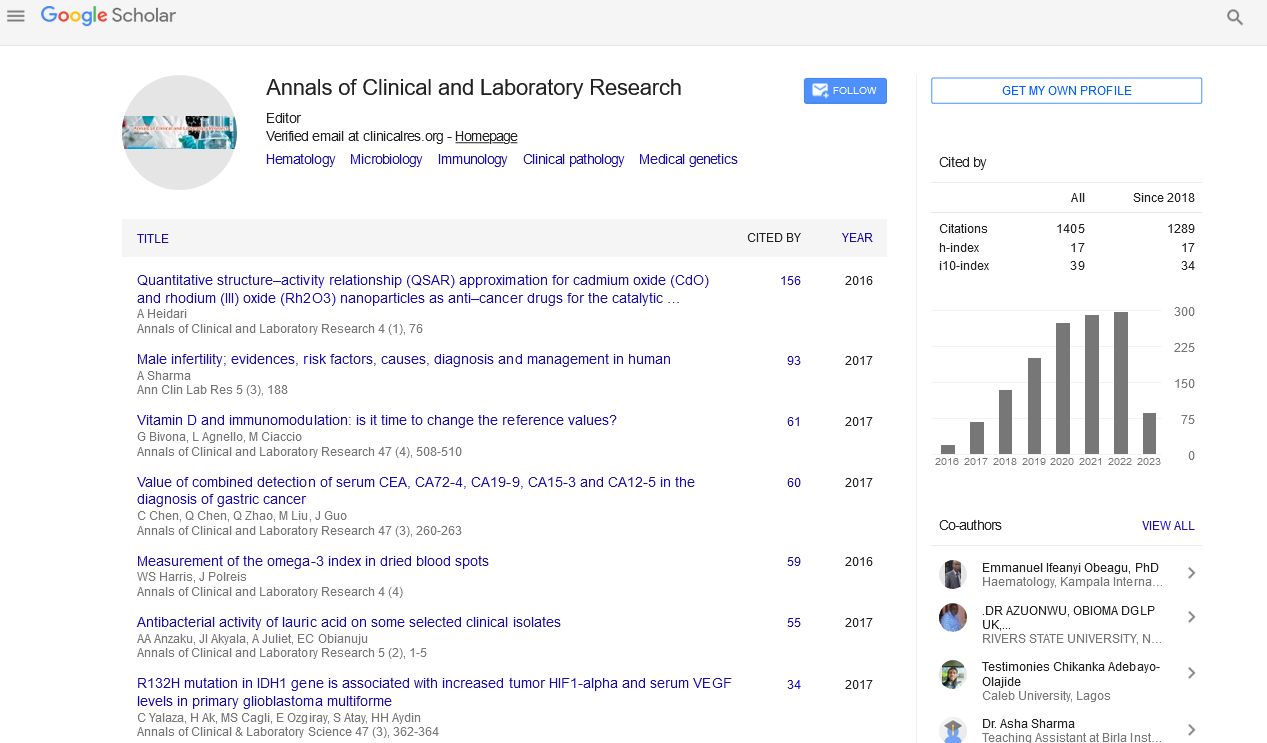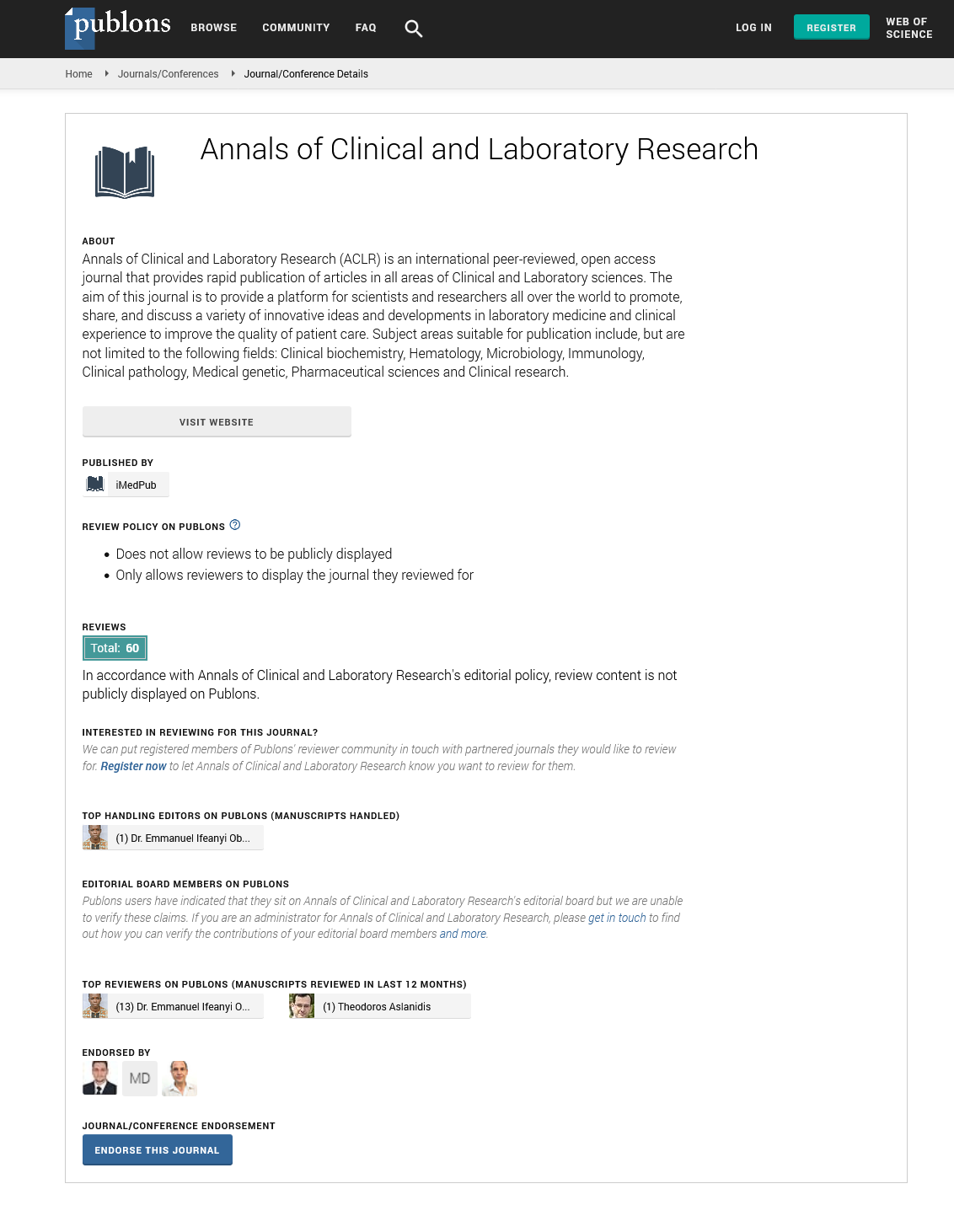Short Communication - (2023) Volume 11, Issue 4
Antiviral drug screening and development for Nipah Virus Infection: Laboratory trials and insights
Louis Margolis*
Department of Chemical and Biological Engineering, University of Saskatchewan, Saskatchewan, Canada
*Correspondence:
Louis Margolis, Department of Chemical and Biological Engineering, University of Saskatchewan,
Saskatchewan,
Canada,
Email:
, Manuscript No. IPACLR-23-13926;
, DOI: 10.36648/2386- 5180.23.11.479
Introduction
Nipah Virus (NiV) is a highly pathogenic zoonotic virus that
belongs to the Paramyxoviridae family. It was first identified in
1999 during an outbreak in Malaysia and Singapore, and since
then, sporadic outbreaks have occurred in several countries,
primarily in South Asia. NiV infection is associated with severe
respiratory and neurological symptoms, including encephalitis,
and has a high fatality rate, ranging from 40% to 75%. Currently,
there are no approved antiviral drugs specifically targeting NiV,
highlighting the urgent need for the development of effective
therapeutic interventions. This article provides insights into the
laboratory trials and advancements in antiviral drug screening for
NiV infection [1].
Antiviral drug discovery for NiV infection involves various
screening approaches, including in vitro and in vivo assays. In vitro screening methods are performed using NiV-infected
cell cultures, allowing researchers to evaluate the efficacy of
potential antiviral compounds. Commonly used assays include
plaque reduction assays, viral yield reduction assays and cell
viability assays. These methods provide valuable information
about the antiviral activity and cytotoxicity profiles of candidate
compounds [2].
Insights from in vitro studies: Several studies have identified
potential antiviral candidates using in vitro screening
approaches. One such study by Rockx et al. (2018) screened
a library of FDA-approved drugs against NiV in vitro and
identified several compounds with significant antiviral activity.
Notably, the antimalarial drug chloroquine showed promising
results by reducing NiV replication. Other compounds, such as
mycophenolic acid and tilorone, also demonstrated inhibitory
effects on NiV replication. These findings provide a foundation
for further investigation and development of these compounds
as potential antiviral therapeutics [3].
In vivo models: To assess the efficacy of antiviral compounds
in a more complex biological context, animal models are
utilized. The development of suitable animal models for NiV
infection has been a critical step in advancing antiviral drug
research. The golden Syrian hamster model and the African
green monkey model have been commonly used to evaluate
antiviral interventions. These models mimic key aspects of NiV infection observed in humans and allow researchers to study
viral pathogenesis, test drug candidates, and assess their safety
and efficacy. One potential antiviral candidate for NiV infection
is remdesivir, a broad-spectrum antiviral drug that has shown
effectiveness against other RNA viruses such as Ebola and SARSCoV-
2. In a study by Lo et al [4]. (2021), remdesivir demonstrated
potent antiviral activity against NiV both in vitro and in a hamster
model. The study reported a significant reduction in viral load
and improved survival rates in remdesivir-treated animals. These
findings support further investigation of remdesivir as a potential
therapeutic option for NiV infection.
Another promising approach involves the use of monoclonal
Antibodies (mAbs) targeting the NiV envelope glycoprotein (G).
A study by Zhu et al. (2018) identified two neutralizing mAbs,
m102.4 and m102.3, which showed potent antiviral activity
against NiV in vitro. These mAbs effectively neutralized multiple
strains of NiV and protected hamsters from lethal NiV challenge.
The development and utilization of mAbs hold great promise as a
therapeutic strategy for NiV infection [5].
Conclusion
The development of effective antiviral drugs for NiV infection is
crucial to combat this deadly virus. Laboratory trials employing in
vitro and in vivo screening approaches have identified potential
candidates, including repurposed drugs like chloroquine and
remdesivir, as well as monoclonal antibodies targeting the NiV
envelope glycoprotein. These studies provide valuable insights
into the mechanisms of NiV infection and offer hope for the development of effective therapeutic interventions against
this deadly virus. Further research, including clinical trials, is
warranted to advance these candidates towards approval and
use in clinical settings, ultimately reducing the morbidity and
mortality associated with NiV infection.
References
- Cyrille M, Catherine LL, Branka H (2011). Transcriptome Signature of Nipah Virus Infected Endothelial Cells.
Indexed at, Google Scholar, Cross Ref
- Guedj J, Piorkowski G, Jacquot F, Madelain V, Nguyen TH, et al (2018). Antiviral efficacy of favipiravir against Ebola virus: A translational study in cynomolgus macaques. Plos Med. 15(3):e1002535.
Indexed at, Google Scholar, Cross Ref
- Lacroix C, Jolles A, Seabloom EW, Power AG, Mitchell CE,et al (2014). Non-random biodiversity loss underlies predictable increases in viral disease prevalence. J R Soc Interface. 11(92):20130947.
Indexed at, Google Scholar, Cross Ref
- Lu P, Guerin DJ, Lin S, Chaudhury S, Ackerman ME, et al (2021). Immunoprofiling correlates of protection against SHIV infection in adjuvanted HIV-1 pox-protein vaccinated rhesus macaques. Front immunol. 12:625030.
Indexed at, Google Scholar, Cross Ref
- Manoharan L, Olliaro P, Horby PW, Watson CH (2021). Chemoprophylaxis trial designs in epidemics: insights from a systematic review of COVID-19 study registrations. Trials. 22(1):370.
Indexed at, Google Scholar, Cross Ref
Citation: Margolis L (2023) Antiviral Drug Screening and Development for Nipah Virus Infection: Laboratory Trials and Insights. Ann Clin Lab Res. Vol.11 No.4:479






